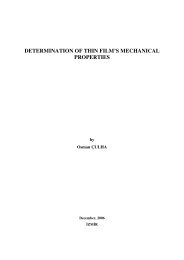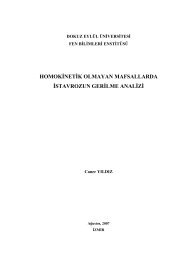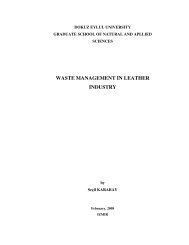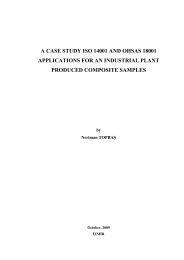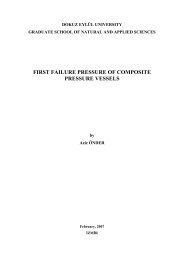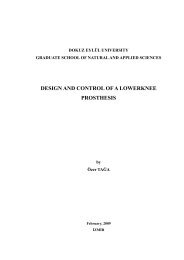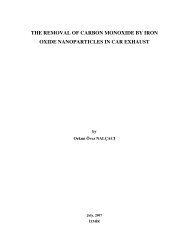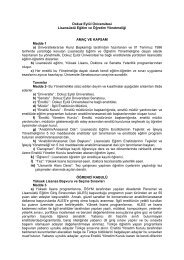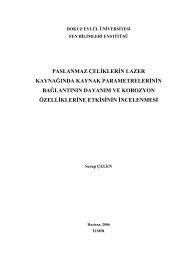A numerical study on the thermal expansion coefficients of fiber
A numerical study on the thermal expansion coefficients of fiber
A numerical study on the thermal expansion coefficients of fiber
Create successful ePaper yourself
Turn your PDF publications into a flip-book with our unique Google optimized e-Paper software.
18<br />
use is in aircraft industry followed by sport and leisure equipment and industrial<br />
equipment.<br />
2.2.2.3 Ceramic Fibers<br />
Although producti<strong>on</strong> <strong>of</strong> ceramic <strong>fiber</strong>s began in <strong>the</strong> 1940s, <strong>the</strong>ir commercial<br />
exploitati<strong>on</strong> did not occur until <strong>the</strong> early 1970s. Worldwide producti<strong>on</strong> <strong>of</strong> ceramic<br />
<strong>fiber</strong>s in <strong>the</strong> early-to-mid 1980s was estimated at 70 to 80 milli<strong>on</strong> kg, with U.S.<br />
producti<strong>on</strong> comprising approximately half that amount. With <strong>the</strong> introducti<strong>on</strong> <strong>of</strong> new<br />
ceramic <strong>fiber</strong>s for new uses, producti<strong>on</strong> has increased significantly over <strong>the</strong> past<br />
decades (IARC, 1988).<br />
Ceramic <strong>fiber</strong>s comprise a wide range <strong>of</strong> amorphous or crystalline, syn<strong>the</strong>tic<br />
mineral <strong>fiber</strong>s characterized by <strong>the</strong>ir refractory properties (i.e., stability at high<br />
temperatures). They are typically made <strong>of</strong> alumina, silica, and o<strong>the</strong>r metal oxides or,<br />
less comm<strong>on</strong>ly, <strong>of</strong> n<strong>on</strong>oxide materials such as silic<strong>on</strong> carbide. Most ceramic <strong>fiber</strong>s<br />
are composed <strong>of</strong> alumina and silica in an approximate 50/50 mixture. M<strong>on</strong>oxide<br />
ceramics, such as alumina and zirc<strong>on</strong>ia, are composed <strong>of</strong> at least 80% <strong>of</strong> <strong>on</strong>e oxide,<br />
by definiti<strong>on</strong>; generally <strong>the</strong>y c<strong>on</strong>tain 90% or more <strong>of</strong> <strong>the</strong> base oxide and specialty<br />
products may c<strong>on</strong>tain virtually 100%. N<strong>on</strong>oxide specialty ceramic <strong>fiber</strong>s, such as<br />
silic<strong>on</strong> carbide, silic<strong>on</strong> nitride, and bor<strong>on</strong> nitride, have also been produced. Since<br />
<strong>the</strong>re are several types <strong>of</strong> ceramic <strong>fiber</strong>s, <strong>the</strong>re is also a range <strong>of</strong> chemical and<br />
physical properties. Most <strong>fiber</strong>s are white to cream in color and tend to be<br />
polycrystallines or polycrystalline metal oxides (Figure 2.5).<br />
C<strong>on</strong>tinuous ceramic <strong>fiber</strong>s present an attractive package <strong>of</strong> properties. They<br />
combine ra<strong>the</strong>r high strength and elastic modulus with high-temperature capability<br />
and a general freedom from envir<strong>on</strong>mental attack. These characteristics make <strong>the</strong>m<br />
attractive as reinforcements in high-temperature structural materials. There are three<br />
ceramic <strong>fiber</strong> fabricati<strong>on</strong> methods: chemical vapor depositi<strong>on</strong>, polymer pyrolysis,<br />
and sol-gel techniques.





